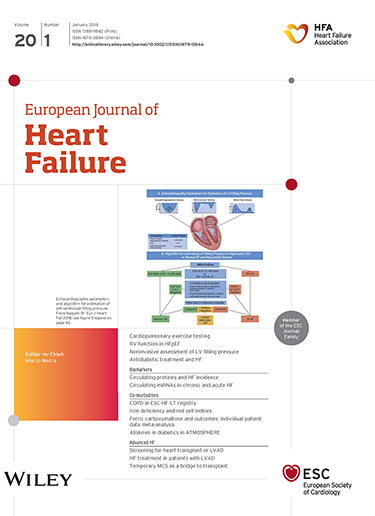Characterization of arrhythmia-induced cardiomyopathy using magnetic resonance imaging in patients with persistent atrial fibrillation and left ventricular systolic dysfunction - insights from DECAAF II.
IF 16.9
1区 医学
Q1 CARDIAC & CARDIOVASCULAR SYSTEMS
引用次数: 0
Abstract
AIMS Atrial fibrillation (AF) ablation in heart failure reduces mortality and hospitalizations and improves ejection fraction. Arrhythmia-induced cardiomyopathy (AIC) is diagnosed after complete recovery of left ventricular systolic function after ablation. We aimed to identify the prevalence and pre-ablation predictors of AIC among patients with AF and left ventricular systolic dysfunction (LVSD). METHODS AND RESULTS We utilized the DECAAF II database, where 815 patients with persistent AF underwent late gadolinium enhancement cardiac magnetic-resonance imaging (LGE-CMR) before and 3 months after AF ablation. We only included patients with available left ventricular ejection fraction (LVEF) and LVSD. AF burden was continuously monitored. AIC was defined as LVSD and coexisting AF in patients with ejection fraction improvement to ≥50% following ablation. We identified 119 patients with LVSD and AF with a mean LVEF of 39.1 ± 7.8% and mean baseline fibrosis of 20.0 ± 7.3%. Mean AF burden post-ablation was 16.8 ± 20.2%, and mean LVEF recovery was 13.9 percentage points. Seventy-two patients (60.5%) fulfilled the criteria for AIC, and 47 (39.5%) did not. AIC patients had a mean baseline LVEF of 39.1 ± 7.9% (vs. 39.2 ± 7.9% in non-AIC patients; p = 0.9), a significantly lower percentage of fibrosis in the left atrial septal wall (12.2 ± 10.0% vs. 20.7 ± 11.4% in non-AIC patients, p < 0.001). Additionally, LVEF improvement was correlated with lower AF burden post-ablation (r = -0.23, p = 0.02). CONCLUSIONS In this post-hoc analysis of the DECAAF II trial, we found that the majority of patients with LVSD and persistent AF have AIC rather than primary cardiomyopathy. We identified LGE-CMR as a differentiator between AIC and other cardiomyopathies.持续心房颤动和左心室收缩功能障碍患者的磁共振成像对心律失常引起的心肌病的表征——来自DECAAF II的见解
心衰患者心房颤动(AF)消融可降低死亡率和住院率,提高射血分数。心律失常性心肌病(AIC)是在消融后左心室收缩功能完全恢复后诊断的。我们的目的是确定房颤和左心室收缩功能障碍(LVSD)患者中AIC的患病率和消融前预测因素。方法和结果我们利用DECAAF II数据库,其中815例持续性房颤患者在房颤消融前和消融后3个月接受了晚期钆增强心脏磁共振成像(LGE-CMR)。我们只纳入了具有可用左室射血分数(LVEF)和LVSD的患者。连续监测心房颤动负荷。AIC被定义为在消融后射血分数改善到≥50%的患者中LVSD和房颤共存。我们确定了119例LVSD和房颤患者,平均LVEF为39.1±7.8%,平均基线纤维化为20.0±7.3%。消融后平均房颤负担为16.8±20.2%,平均LVEF恢复为13.9个百分点。72例(60.5%)符合AIC标准,47例(39.5%)不符合AIC标准。AIC患者的平均基线LVEF为39.1±7.9%(非AIC患者为39.2±7.9%;p = 0.9),左房间隔壁纤维化比例显著低于非aic患者(12.2±10.0% vs. 20.7±11.4%,p < 0.001)。此外,LVEF改善与消融后房颤负担降低相关(r = -0.23, p = 0.02)。在这项对DECAAF II试验的事后分析中,我们发现大多数LVSD和持续性房颤患者患有AIC而不是原发性心肌病。我们确定LGE-CMR是AIC和其他心肌病的鉴别指标。
本文章由计算机程序翻译,如有差异,请以英文原文为准。
求助全文
约1分钟内获得全文
求助全文
来源期刊

European Journal of Heart Failure
医学-心血管系统
CiteScore
27.30
自引率
11.50%
发文量
365
审稿时长
1 months
期刊介绍:
European Journal of Heart Failure is an international journal dedicated to advancing knowledge in the field of heart failure management. The journal publishes reviews and editorials aimed at improving understanding, prevention, investigation, and treatment of heart failure. It covers various disciplines such as molecular and cellular biology, pathology, physiology, electrophysiology, pharmacology, clinical sciences, social sciences, and population sciences. The journal welcomes submissions of manuscripts on basic, clinical, and population sciences, as well as original contributions on nursing, care of the elderly, primary care, health economics, and other related specialist fields. It is published monthly and has a readership that includes cardiologists, emergency room physicians, intensivists, internists, general physicians, cardiac nurses, diabetologists, epidemiologists, basic scientists focusing on cardiovascular research, and those working in rehabilitation. The journal is abstracted and indexed in various databases such as Academic Search, Embase, MEDLINE/PubMed, and Science Citation Index.
 求助内容:
求助内容: 应助结果提醒方式:
应助结果提醒方式:


